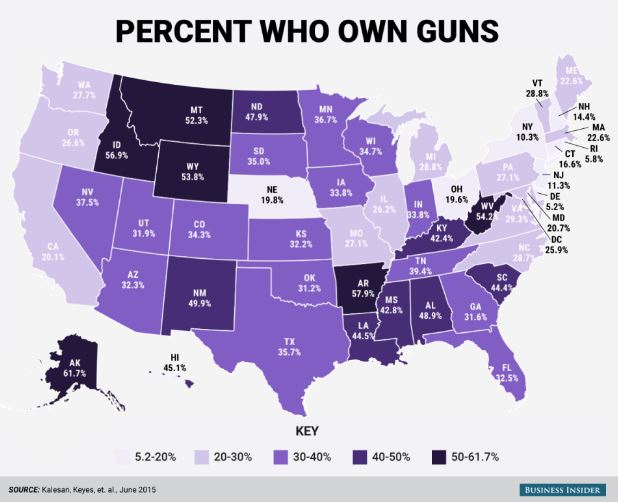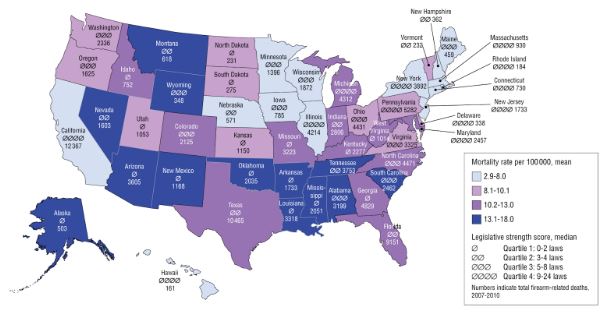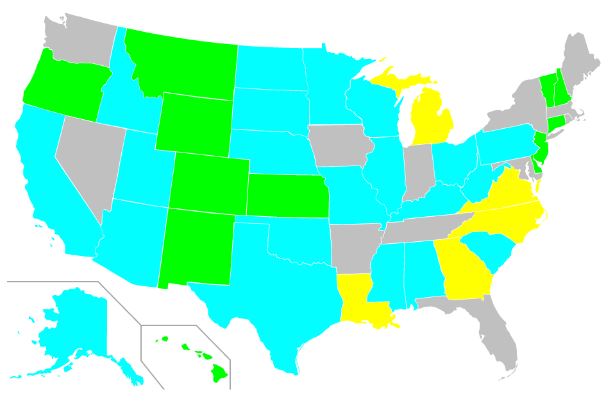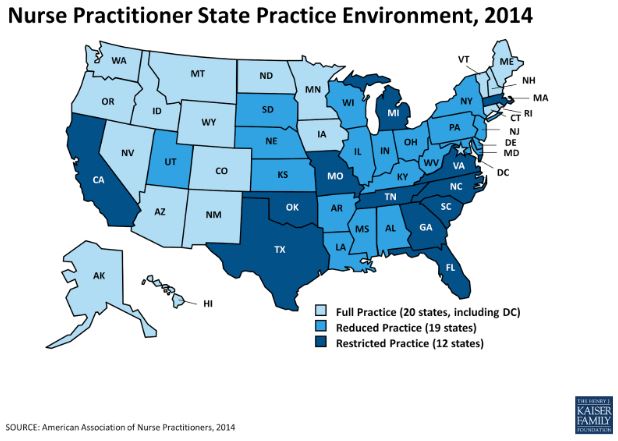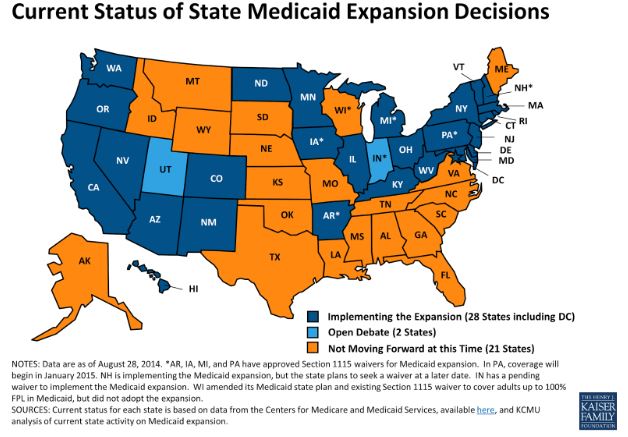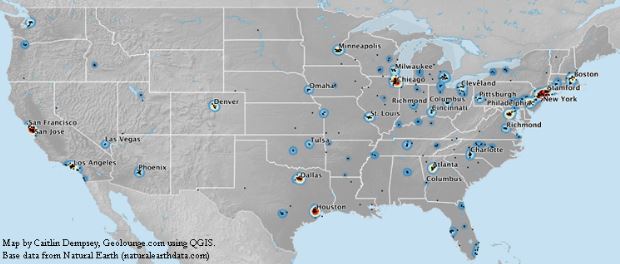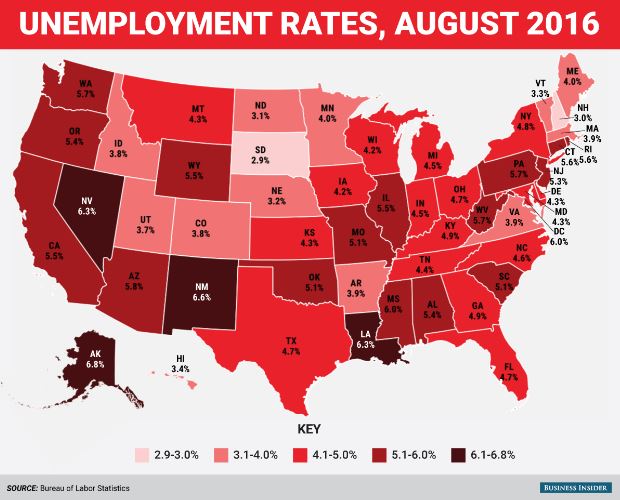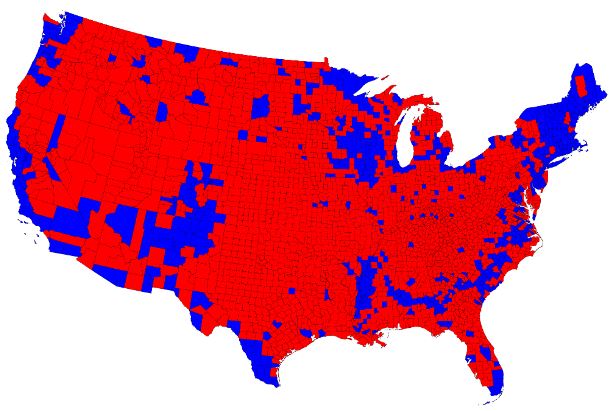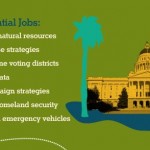In the uncertain times following this election, one thing is for sure. Things will change over the next few years with a Republican president bent on change and a congress likely to cooperate with him.
Using GIS data is not just about showing the way things are, but from the demographic information we gathered during the election combined with other data, we can make some predictions of what might come next with regard to some of the campaign promises Donald Trump made during his campaign and things he has said since.
The Second Amendment and Gun Laws
Many conservatives feel that gun laws should be regional or determined state by state instead of federally. Many pro-Second Amendment supporters have now been elected. What states have the strictest gun laws, and what is likely to change about that over the next few years?
Map Courtesy: Business Insider
The map above shows the states where a citizen is most likely to own a gun. The map below shows the deaths by firearms adjusted for population. Gun ownership and risk of death by firearm do not exactly overlap, but clearly there is a correlation between the two.
Still the debate over gun control and its effectiveness is far from over. Data varies, however with a Republican president and congress, Federal laws are likely to relax or change very little. Many conservatives and others will argue gun laws are better handled by the states anyway, since the reasons for owning a gun and the cause of deaths by firearms varies greatly by region and even city.
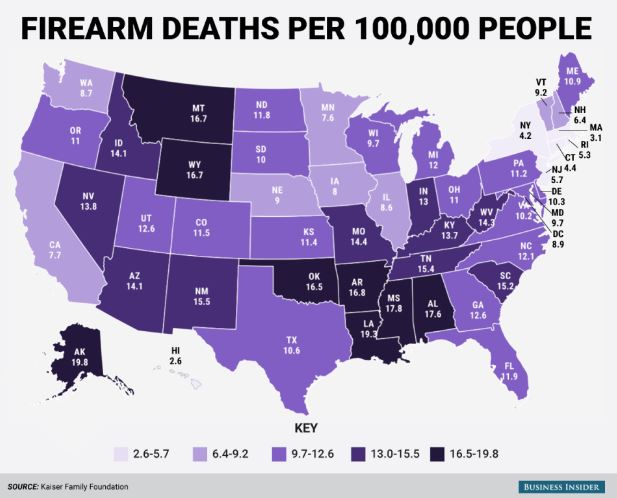 Map Courtesy Business Insider
Map Courtesy Business Insider
Map Courtesy Policy.Mic
No matter what your take on the gun control issue, the issue will likely take center stage sometime in the next four years, and gun laws will change, especially at the state level.
Roe v. Wade and Abortion Rights
In an interview on CBS’s 60 Minutes Trump gave us some insight on his plans for appointing Supreme Court justices, indicating they would be Pro-Life. He also stated correctly that there is a long way to go before Roe v. Wade could be overturned, one of the many concerns Democrats have about the future of the court.
What states have the most abortion regulation already in place? What states would be most likely to make abortion illegal? The answer lies in these maps:
Map courtesy Lokal Profil via Wikimedia Commons
This map shows states where abortion was illegal before Roe v, Wade in red. The states in yellow were where abortion was legal upon request. All of the other states had restrictions.
Map courtesy Lokal Profil via Wikimedia Commons
This map shows states where killing a fetus is considered homicide highlighted in blue. States in yellow have laws prohibiting other crimes against a fetus. States in gray have laws that vary by the age of the fetus, and states in green have special laws regarding assaults against a pregnant woman.
According to the Guttmacher Institute, 23 states have or would enact laws to make abortion illegal in the absence of Roe. So if it were overturned as a result of a Trump presidency, the abortion map would look quite different.
The Affordable Care Act Repeal and/or Reform
Since the implementation of the Affordable Care Act. the face of healthcare has changed significantly due to regulation. For many, premiums have actually increased. More than that, the role of nurses and doctors has changed.
More people signing up for healthcare means a higher demand for medical professionals, In response many states have expanded the role of Nurse Practitioners. Traditionally these skilled nurses still had to work under the practice of a doctor, but some states now allow them to work independently.
One of the most significant areas of impact has been the need for Nurse Practitioners in women’s health. Since insurance must cover certain preventative health screenings, the demand for those services has increased, and Nurse Practitioners have stepped into those roles.
Map Courtesy Kaiser Foundation
The other area of concern has been those states who have not voted to accept medicaid expansion, a program designed to cover the healthcare of low income Amercians. Many states have rejected the expansion, and those Federal funds go to other states (even though their own citizens are paying taxes that support the expansion).
Map Courtesy Kaiser Foundation
Many of the states are concerned about the long term cost of the expansion, and the overall cost of the expansion nationwide. If the Affordable Care Act is repealed, as President Trump has called for, or is even reformed and replaced with something else, it’s almost assured that the medicare expansion map, and therefore the number of Americans covered by medical insurance will change, it’s just a matter of in what way.
Jobs and Industry
Donald Trump has had a feud with Amazon (NASDAQ: AMZN) founder Jeff Bezos and the Washington Post since the outset of his campaign. There were also rumors that Facebook (NASDAQ: FB) filtered the news shown and highlighted in users news feeds to favor Hillary Clinton in the election, a charge Mark Zuckerberg denied. Trump was upset, but what can and will he do about those big tech companies?
Map courtesy GeoLounge
Fortune 1000 companies are spread all over the United States and provide jobs and innovation. WIthout sweeping reform, it would be difficult to target the models of specific companies: what affected the large would also affect the small. Antitrust lawsuits are frequently said to be for the protection of customers, but it is hard to argue that Amazon offering low prices and exceptional service harms the consumer marketplace.
Map Courtesy: Business Insider
Also what will Trump do to bring back jobs, and where will they be located? The map above show unemployment rates by state in August of 2016. While campaigning, Trump made a broad promise to bring American jobs back from overseas. The key will be how he chooses to do so, whether through tough trade deals and tariffs, or by some other means.
Will his plan work, and where will those jobs go? That remains uncertain, but one thing is sure: the map will change.
The Next Election
Thanks to a Republican redistricting effort called Project Redmap, the Electorate and district maps have been reset, and are not likely to change over the next decade. Historically though, the party that holds the presidency loses control of congress in midterm elections. Do democrats have the “map” to accomplish that?
Map Courtesy: Wikimedia
It’s a good question, and one that will not be quickly answered. The Democrats have their own redistricting plan, but it may not even be possible for them to implement it before the next census.
Political maps will change and reform will happen under President Trump. It is just a matter of how much, and what those maps will look like. It will be fascinating to see the shift over the next four years.
Author:
Troy Lambert is a freelance writer, editor, and non-profit consultant by day, and a suspense thriller author by night. He learned about the power of GIS while working as a researcher at a museum, and is always looking for ways to apply this technology and big data in new and innovative ways. Troy is an avid cyclist, skier, and hiker. He lives, works, and plays in Boise, Idaho. His work can be found at troylambertwrites.com, and you can connect with him on Twitter @tlambertwrites.
